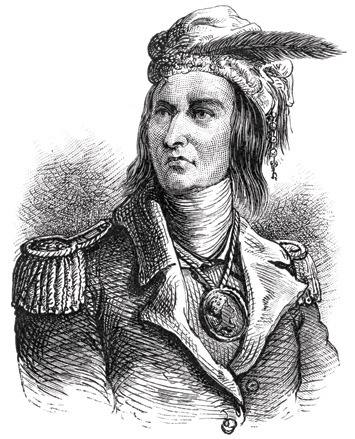https://en.wikipedia.org/wiki/Blackfish_(Shawnee_leader)
Little is known about him, since he only appears in written
historical records during the last three years of his life, primarily
because of his interactions with the famous American frontiersmen
Daniel Boone and
Simon Kenton.
When the Shawnees were defeated by
Virginia in
Dunmore's War in 1774 , the resulting peace treaty made the
Ohio River the boundary between western Virginia (what is now
Kentucky and
West Virginia) and American Indian lands in the
Ohio Country. Although this treaty was agreed to by Shawnee leaders such as
Cornstalk, Blackfish and a number of other leaders refused to acknowledge the loss of their traditional hunting grounds in Kentucky.
Violence along the border escalated with the outbreak of the
American Revolutionary War in 1775. As a result, the Chillicothe Shawnees moved their town on the
Scioto River further west to the
Little Miami River, near what is now
Xenia, Ohio. Encouraged and supplied by
British officials in
Detroit,
Blackfish and others launched raids against American settlers in
Kentucky, hoping to drive them out of the region. In revenge for the
murder of Cornstalk by American
militiamen in November 1777, Blackfish set out on an unexpected winter raid in Kentucky, capturing American frontiersman
Daniel Boone and a number of others on the
Licking River
on February 7, 1778. Boone, respected by the Shawnees for his
extraordinary hunting skills, was taken back to Chillicothe and adopted
into the tribe. The traditional tale is that Boone was adopted by
Blackfish himself, although historian
John Sugden suggests that Boone was probably adopted by another family.
Boone escaped in June 1778 when he learned that Blackfish was launching a siege of the Kentucky settlement of
Boonesborough, which commenced in September of that year. The
siege of Boonesborough was unsuccessful, and the Kentuckians, led by Colonel
John Bowman,
counterattacked Chillicothe the following spring. This raid was also
unsuccessful, but Blackfish was shot in the leg, a wound which became
infected and was eventually fatal.
References
- Faragher, John Mack. Daniel Boone: The Life and Legend of an American Pioneer. New York: Holt, 1992.
- Lofaro, Michael. Daniel Boone: An American Life. Lexington, KY: University Press of Kentucky, 2003.
- Sugden, John. "Blackfish" in American National Biography. Oxford University Press, 1999.
Piqua Shawnee
www.piquashawnee.com




